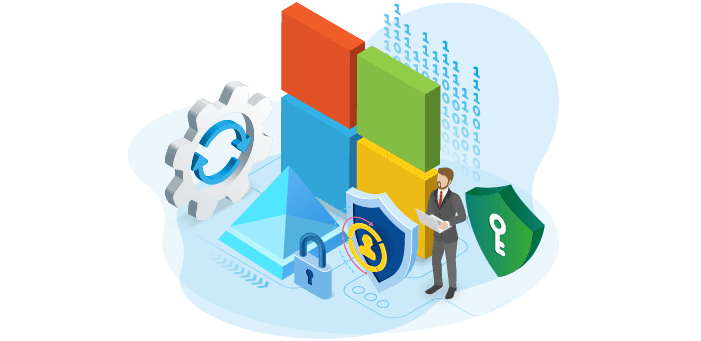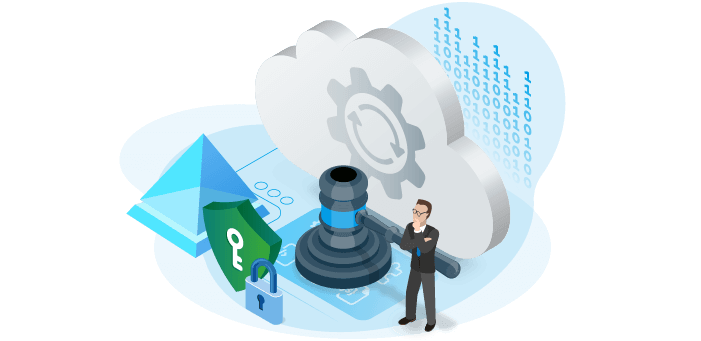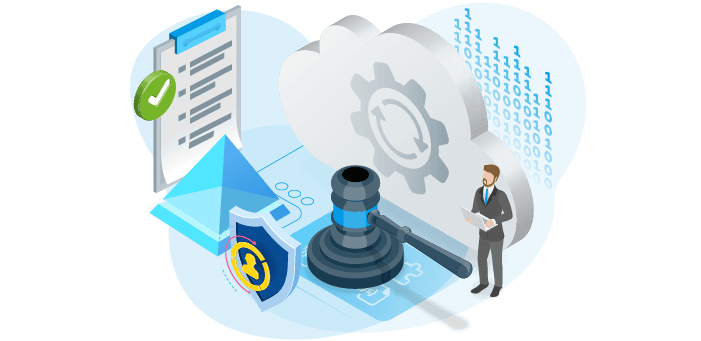How many cloud services does your business use? Can you count them on one hand?
The last few years have seen a dramatic shift toward the cloud and businesses are now using a number of cloud apps at work. The problem? If these aren’t correctly governed, collaboration between users can break down.
Enter Azure Active Directory (Azure AD): a cloud-based access and identity management service from Microsoft. Azure AD makes managing access to cloud apps a much simpler prospect for your IT team and fosters collaboration across an organization and its external partners. But how does it work? And what are the Azure AD identity governance best practices for your admins to keep collaboration afloat? Let’s take a look.
Azure Active Directory: how does it work?

Azure AD works for businesses in different ways, offering a range of features including:
Single sign-on
Allows users to access the applications they use every day – but without the need to remember multiple passwords and sign in multiple times. One set of credential is usually enough for the most common use cases.
Multi-factor authentication
Increases your organization’s security, and better prevents cyber-attacks from malicious actors. When collaborating with external partners, MFA ensures that this collaboration is well governed and secure. Don’t forget with Azure AD Conditional Access Policies we have the flexibility to balance between Security and Usability depending on where users are signing-in from.
Passwordless authentication
This is a recently released capability of Azure AD meant to make the life of our users even better while keeping the threat actors out of our systems. If there is no password to steel there is no password to abuse. It is that simple.
Multi-device registration
A hallmark of the remote work movement, and security concern for IT, has been employees accessing work accounts through home devices (personal laptops, smartphones). Azure Active Directory allows businesses to register employees’ personal devices for work use – don’t forget to check the applicable local laws and regulations covering the use of personal devices for work purposes. Additional Microsoft tools (e.g. Microsoft Intune) also provide extra security and management capabilities for you.
Self-Service password reset
This feature takes password management off busy IT teams and puts it in the hands of employees. IT staff can then focus on the tasks that matter and engage more quickly in collaborative projects. Be aware that SSPR requires Azure AD Premium P1 license.
Access reviews (not the Premium feature)
With so many employees dispersed in different locations, it’s important to keep an eye on who has access to which applications and the data within. Azure AD lets IT monitor and control access to company applications and vary to what degree an employee can see company information.
Actionable reporting
Azure AD gives you a single-pane view of your business applications. With Azure, you can see which applications are most popular, which sign-in errors are most common, and which applications are used most – and least – often.
What is Azure AD identity governance?

Azure AD identity governance is a set of processes, and tools, that ensures your organization, and its external collaborators, have access to the correct resources. This helps employees collaborate better, keeps your teams productive, and better secures your data in the cloud.
Benefits of Azure AD for collaboration
Use Azure Active Directory to:
- Give employees access to the right resources for the right length of time.
- Provide clarity on the ownership of access.
- Prevent sensitive resources from being exposed.
- Secure your digital ecosystem (especially with remote employees and external partners).
- Facilitate easy login and access to resources.
- Streamline processes across a project.
- Provide clear lines of communication, for easy collaboration
If job information is active, you can see information such as who their manager is, which department they work in and what their title is. Azure Active Directory Admin Center also allows you to set consent settings (if any users are minors) and you can reset authentication settings on an account-by-account basis too. Here you’ll also find Roles, which allows you to grant privileged access to certain users, based on their job responsibilities.
Azure AD identity governance best practices

Consider Azure Active Directory the gatekeeper to your Microsoft environment. It helps you manage authentication, access, and reporting on all of your cloud applications. However, it’s also the target of increasingly sophisticated cyberattacks.
A malicious actor who gains access to Azure AD can hack into Azure AD Connect, discover user passwords, and compromise admin accounts. To better protect your corporate data, follow these Azure AD identity governance best practices:
Reduce the number of domain admin accounts
Domain admin accounts are most vulnerable to being hacked by cyber criminals, as they contain more sensitive information, connected to multiple cloud apps in an organization. Limiting these accounts gives hackers fewer entry points into your digital ecosystem.
Review permissions regularly
“Access sprawl” is a real problem in cloud environments. Although admins might set rigid access permissions to begin with, over time accounts with more lax permissions tend to multiply like rabbits. Before you know it, you have hundreds of privileged accounts across your apps, which then pose a security threat to your ecosystem. Regularly reviewing processes keeps access sprawl in check and minimizes the number of backdoor entry points for hackers.
Monitor your apps
By regularly monitoring your cloud environments, you can see if any unusual activity is afoot. Watch out for strange geo-location logins, numerous failed sign-in attempts, and anything else that diverges from the norm.
Enable MFA
Multi-factor authentication should be enabled for all employees, and not just administrators. Although it’s best to prioritize those accounts with privileges, as these are most vulnerable to attacks, every employee account should have MFA enabled – to best shield your organization from cyber threats.
Enforce secure password policies
Just one weak password from one employee can compromise your Azure AD environment. As a result, it’s important to educate your employees on secure password policies.
Use Passwordless authentication as a replacement to password policies
Your users will appreciate it.
Automate your Azure AD Identity Governance
Azure AD identity governance gives a structure to the way Azure AD is used, to help you best manage its security. It helps you do all this while ensuring that employees remain productive.
The best solution for most organizations is to automate governance processes with third-party tools. Having a central dashboard to quickly identify and flag security concerns or violations and monitor and correct deviations from Azure AD best practices frees up valuable time for IT admins. An automated solution, like Rencore Governance, keeps Azure AD identity governance in check and helps your organization collaborate better.
I also highly recommend reading the following whitepaper: Complete visibility across Microsoft 365. This whitepaper provides a framework built on best practices to help you compile a combined governance strategy to help your organization stay compliant and secure.



